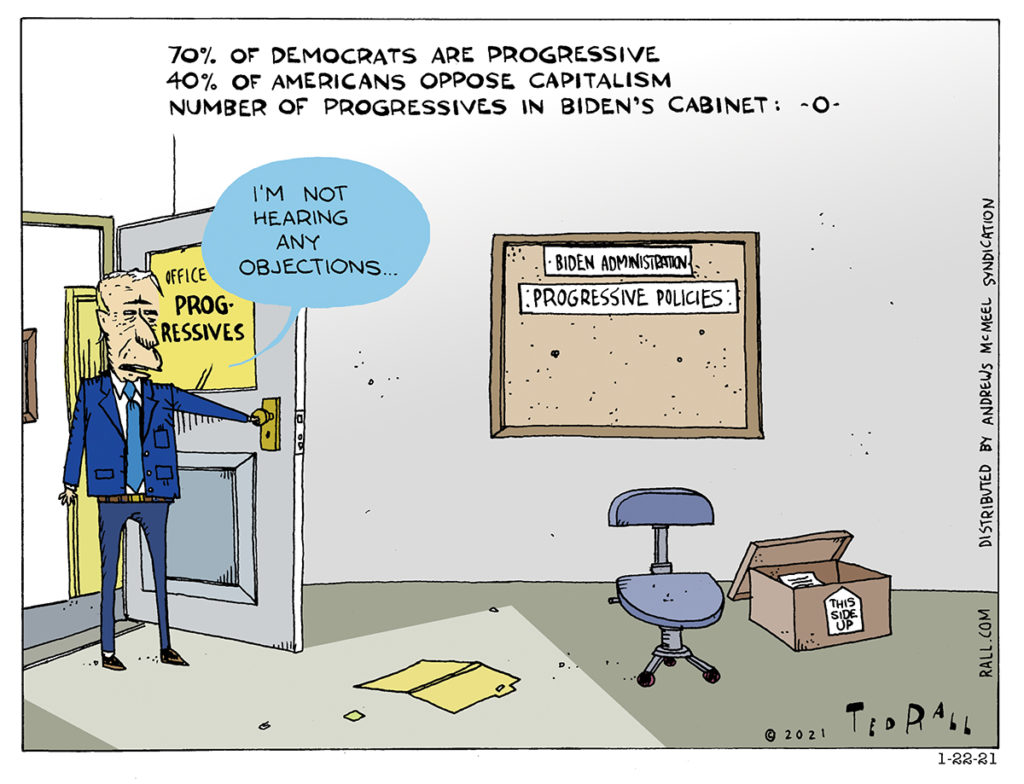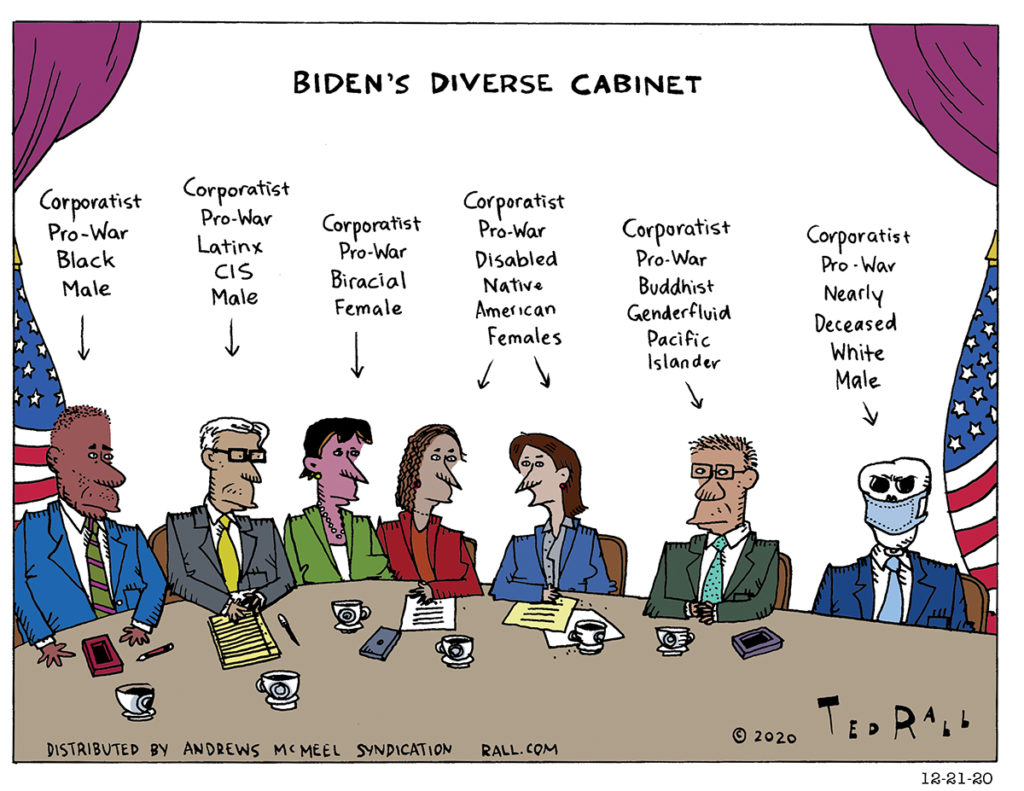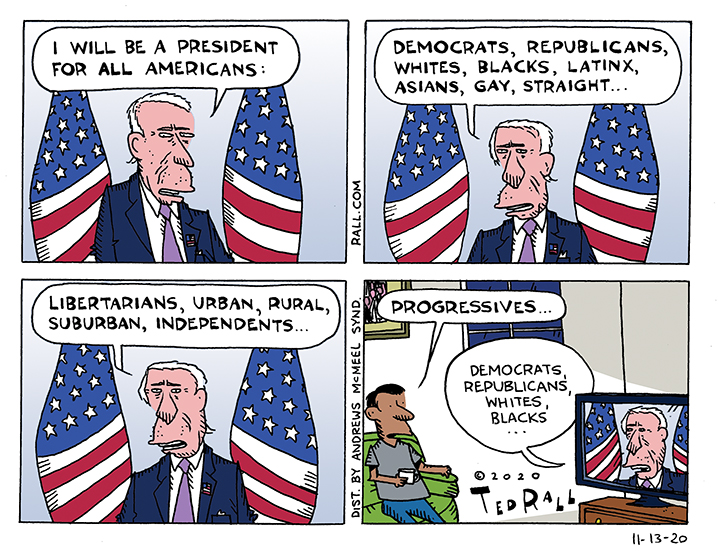By definition, terrorism is violence aimed at effecting political change. The only way to defeat terrorism, therefore, is to remain unchanged. Wallowing in revenge and exploiting the opportunities it presents reveals you as the monster the terrorists claim you are, and it changes you, so you lose.
A Movement Beats a Party Every Time
 As Democrats continue to deconstruct the root causes of their recent defeat and attempt to regroup for next year’s midterm elections, they might want to consider a new factor in American politics: the seductive power of a movement compared to a boring old party.
As Democrats continue to deconstruct the root causes of their recent defeat and attempt to regroup for next year’s midterm elections, they might want to consider a new factor in American politics: the seductive power of a movement compared to a boring old party.
On the surface, the 60th American presidential election was the usual two-way contest between the Democratic and Republican parties. But, as Democrats tried their best to run as normal and competent a campaign as they could despite Biden’s ill-timed withdrawal, Trump had re-branded and re-organized the Republican Party as a vessel of his MAGA movement.
A movement is dynamic. Its number-one goal is building excitement and a sense of belonging.
A party strives for constancy. It represents a set of principles through thick and thin.
All things being equal, a movement beats a party.
“The difference between parties and movements is simple,” the progressive pundit David Sirota wrote back in 2009. “Parties are loyal to their own power regardless of policy agenda. Movements are loyal to their own policy agenda regardless of which party champions it.” Democrats who were skeptical of military interventionism under Bush embraced it under Biden yet remained Democrats; the abortion-rights movement would vote Republican if the GOP were to come out as firmly pro-choice.
Donald Trump has scrambled Sirota’s formulation.
Trump has built a highly-personalized movement detached from any discrete policy prescription. Rather than remain independent of party politics, his MAGA movement seized control of the Republican Party. Despite having achieved a sweeping victory, MAGA continues to act like an outsider insurgent movement.
Personality is everything. The dauphin J.D. Vance notwithstanding, it is impossible to imagine the MAGA movement without Trump. While I don’t give much credence to arguments that the president is a Nazi-in-waiting, there is an echo of the Führer Principle that gave the force of law to anything Adolf Hitler said. MAGA Trumpism is anything that Trump says at any given time.
At first glance at the man on the golden escalator in 2015, this highly individuated politics seems ill-fated. Trumpism is riddled with internal contradictions and existential hypocrisies. Trump’s habit of reversing himself, as he did recently by threatening Russia only to turn around and embrace it after a call to Putin seems destined, by traditional political standards, to turn off supporters who care about those issues. So does the conflict between his personal and political lives; surely evangelicals will turn against a crude serial adulterer who screws porn stars and doesn’t appear to have ever darkened the door of a church in session.
People who evaluate Trump by traditional metrics fail to understand that everything has changed. For a party, Trump’s inconsistencies and changing his mind 180° would be weaknesses to overcome or explain away. Not so for a movement. First and foremost, a movement moves. Where and how it moves is beside the point.
A movement is entertaining. Think about Trump and his wild and crazy rants, not as appalling or racist but as unpredictable—and thus interesting. Think about Trump supporters and their giant flags, their sense of community.
Trump kept holding rallies throughout his first term—a party doesn’t do that. A movement does. A party doesn’t stick with an individual politician through thick and thin, as Trump supporters did through his legal troubles. A movement does. It has to, because it’s all about one man.
If there is a 20th century authoritarian parallel to Trump, I have argued before, it is not the totalitarianism of Hitler but the culturally-centered rule of Mussolini. As the Italian novelist and semiotician Umberto Eco, who grew up under Italian fascism, noted, “Contrary to common opinion, fascism in Italy had no special philosophy.” Mussolini, who started out as a socialist journalist, came to believe that people were drawn to action—any action—for its own sake. “Action being beautiful in itself, it must be taken before, or without, any previous reflection,” Eco wrote in an influential essay about fascism in 1995. “Thinking is a form of emasculation.”
Writing at Salon, Chauncey DeVega complains: “President Trump and his MAGA Republicans and their forces are smashing American democracy, the Constitution, the rule of law, the institutions and norms. Trump has enacted over 50 executive orders since Jan. 20, the most in a president’s first 100 days in more than 40 years. Some of the most egregious ones are blatantly unconstitutional and violate current law.” DeVega blames the media for normalizing Trump and Democrats for not taking him seriously enough to convince voters.
What such mainstream analyses dismiss is how soul-deadening the technocrats who run the West have been. Not only have they been unresponsive to people’s complaints about internationalism and declining living standards, they have been boring.
Democrats (and many Republicans) have repeatedly run on not promising anything. The only surprise is that they got away with it for so long.
Whether Trump is influenced by Mussolinian tactics, or his acute political instincts rediscovered the potency of a “cult of action,” the United States was primed for the politician Trump had become by the time he ran a third time in 2024—energetic, focused, retributive, imaginative—and stormed out of his inaugural ceremony with a blizzard of pardons, sweeping executive orders and bold diplomatic initiatives.
Asked if she would have done anything differently than Joe Biden during his presidency, Kamala Harris said: “There is not a thing that comes to mind.”
And, four years earlier, Biden told a group of wealthy campaign donors that, were he to be elected, “Nothing would fundamentally change.” Turns out, he was truthful. Nearly a third of those who voted for him in 2020 didn’t turn out for Harris in 2024.
Liberal Democrats I talk to are depressed and disengaged in this, the first month of the second term of Trump. They’re also jealous. Why, they ask, won’t the Democrats run a candidate who campaigns and governs as aggressively as Trump is doing now?
As for those Democrats, the party faces a choice as it prepares to challenge MAGAism. It can reconstitute itself into something that looks and feels more like a movement, far less careful and far more energetic. Or it can keep going as a party that promises that nothing will ever fundamentally change.
(Ted Rall (Twitter: @tedrall), the political cartoonist, columnist and graphic novelist, co-hosts the left-vs-right DMZ America podcast with fellow cartoonist Scott Stantis and The TMI Show with political analyst Manila Chan. His latest book, brand-new right now, is the graphic novel 2024: Revisited.)
TMI Show Ep 66: What Is Communism?
With the Democratic Party in disarray and the Left unable to organize itself into a coherent political movement, it’s a good time for Americans who oppose capitalism to get back to the basics of anti-capitalist politics: communism.
Communism is an economic and political system under which everyone lives equally and has equal access to goods, services and power. Socialism is a system that precedes communism, in which the value added by labor is transferred over time from the ruling-class elites who control it under capitalism to the working class that produces it.
40% of American voters consistently tell pollsters they have a favorable view of socialism. We appear to be in a classic Marxist final crisis of late capitalism, overproduction, yet the media and education systems do not permit serious discussion of alternatives to capitalism.
On “The TMI Show,” co-hosts Ted Rall and Manila Chan ask: What is communism exactly? Is it desirable? Is it attainable? Can revolution be achieved non-violently?
The TMI Show Ep 8: What Is Fascism?
As a history major at Columbia University, The TMI Show’s own Ted Rall’s thesis advisor was Professor Robert O. Paxton. Paxton wrote THE book on French fascism, “Vichy France.” He went on to write THE book on fascism writ large, “The Anatomy of Fascism.” Now age 92, Paxton recently gave an interview in which he cautiously agreed with the description of the MAGA movement led by former President Donald Trump as fascist in the traditional 20th century sense of the word. Kamala Harris has also weighed in, calling Trump himself a fascist.
What is fascism? Does Trump fit the bill? What about Trumpism?
Ted and TMI Show Guest Co-host Scott Stantis explain fascism’s historical origins in Italy after World War I through its radical manifestation in Nazi Germany and work to answer the question: is Donald Trump, with a 50% chance of winning the 2024 presidential election, a fascist?
The Left Must Continue to Avoid the Ukraine Trap

“Find a way to be against the war in Ukraine, please.” That was the subject line of one of my recent hate emails. “If you look through Mr. Rall’s cartoons for the past month, there isn’t a single one condemning Russia’s invasion of Ukraine,” an anonymous online commentor chided. “There’s plenty of ones based around whataboutism condemning us for condemning them but not a single one that just comes right out and says what Russia is doing now is wrong.”
The Right—in the U.S. that includes Republicans, Democrats and corporate media—has set a clever trap for the antiwar Left. The rhetoric in this essay’s first paragraph is an example. If the Left were to support Russia’s invasion of Ukraine, the Right would portray us as Russia-loving hypocrites who only oppose wars when the United States starts them. If the Left backed Ukraine, they’d be joining an unholy alliance with a government installed in a CIA-backed coup, that pointlessly provoked Russia by asking to join NATO and is so tolerant of neo-Nazism that it allows soldiers wearing Nazi insignia in its military and is seems to be trying to set some sort of record for building statues to World War II Nazi collaborators and anti-Semites. Plus they’d be helping the Right distract people from the murderous sins of American imperialism, which are ongoing.
Stuck between these two unappetizing prospects, the Left has wisely chosen not to pick sides. Instead, we are pointing out that militarily-aggressive America is too hypocritical to criticize Russia—a stance the Right describes as “whataboutism.”
So the Right is trying to force us to choose sides.
Free speech used to include the right not to speak. No more. New York’s Metropolitan Opera, wallowing in cheap post-9/11-style neo-McCarthyism, fired star soprano Anna Netrebko, a Russian national, because she refused to condemn Russian President Vladimir Putin, and replaced her with a Ukrainian. This was after she criticized the invasion. A Canadian concert canceled an appearance by pianist Alexander Malofeev because the program’s artistic director claimed he could not “in good conscience present a concert by any Russian artist at this moment unless they are prepared to speak out publicly against this war.”
Cancel those who refuse to regurgitate the words we stuff down their throats! Cancel them all!
I refuse to be told what to think and what to say, particularly by the Right. That goes double when the matter involves a complicated foreign policy crisis. I need time to dig into the facts, double- and triple-check and consider where I stand. Whether a hard sell emanates from a realtor, car salesperson or editorial writer at a newspaper, anyone who tries to bully me into a quick decision in their favor gets my freezing-cold shoulder. Threats and ultimata get nowhere fast.
To the extent that anyone should care about Ukraine, they’re in good hands with the Right, which is covering up Ukraine’s neo-Nazis and their ethnic cleansing of the Roma, sending them billions of dollars in cash and weapons and risking thermonuclear war by threatening regime change against Russia. Ukraine doesn’t need the Left too.
We on the Left do not owe anything but ferocious opposition to the political and media establishment that gave us the Afghanistan and Iraq wars. These are the same scum who legalized torture, kneecapped Bernie Sanders and insist that only rich people should be allowed to see a doctor. The Right never helps us, or our overseas allies. If they want to festoon social media and office buildings with Ukrainian flags, let them do it without us.
Any leftist who publicly expresses support for Ukraine and/or criticizes Russia in the current media environment, awash in imperialist propaganda at a fever pitch, is a rube, a dupe, an idiot. A leftist who takes even a second of attention away from the U.S.-created famine in Afghanistan gives aid and comfort to gangster capitalists and allows the butchers of Guantánamo and Fallujah and the Salt Pit to get off scot-free. Jumping on the Ukraine war bandwagon would be the height of tactical foolishness and a betrayal of the fundamental values of the Left.
For the Left, change has to begin here at home.
American leftists are citizens of the wealthiest nation on earth, its biggest and most aggressive military power, backer of the most important currency and, since 1945, so influential that it unilaterally decides whether a place is to be internationally recognized as a nation-state and whether or not its government is legitimate. Whether directly in countries like Vietnam, Panama and Bosnia or by proxy in conflict as in Syria, Yemen and Somalia, the United States has been a key player in almost every major war in the world for decades. The total death count attributable to U.S. forces and proxies in illegal and unjustifiable wars is incalculable, but it numbers in many millions.
The United States starts and prolongs more wars of choice than any other country. Leftists who live in the United States therefore have a special responsibility to work to destroy our country’s cult of militarism.
This is not to say that the Left cannot or should not have opinions about distant conflicts and foreign policy dilemmas on the other side of the planet. It’s a matter of priorities — when you live in a country as powerful and influential as the United States, it makes more sense for the domestic Left to marshal its resources to protest and campaign against America’s own actions as an empire than to worry about, say, China possibly invading Taiwan.
At this writing the United States is backing Saudi Arabia in its brutal campaign in Yemen. The reprehensible torture and detention camp at Guantánamo Bay remains open. Palestinians in Gaza continue to suffer under occupation by Israel, a staunch U.S. ally. Afghans are starving to death in large part because the United States refuses to release Afghan government money to the new Taliban government. These atrocities are directly attributable to the United States.
The more we think and talk about Ukraine, the less we work on our own country, which we have a much better chance of changing.
Rallies and protests directed at your own country, from inside your own country, are infinitely more effective than those that take place overseas. Millions of people marched against invading Iraq in 2003 all over the world. Even though the Bush administration ultimately went to war, the Americans who stood up against their own government right here got far more attention in Washington. The Right’s warmongers didn’t care what the French or the Japanese thought, and why should they?
Conversely, there were hardly any major protests against the invasion and occupation of Afghanistan in the United States, though there were many overseas. The Afghan war probably would have ended sooner if we Americans had demonstrated in a sustained way.
The Left is concerned about many issues. So one of our biggest enemies is distraction. As the 1950s civil-rights song goes, keep your eye on the prize! Police violence, veterans committing suicide, healthcare, the income gap, climate change, homelessness, and a Congress that spends billions of dollars on weapons for Ukraine while kids go into debt to attend college are problems that no one but the Left is going to care about, much less try to fix. Russia’s actions in Ukraine are a big fat distraction on the other side of the planet at a time when we have a lot to do right here at home.
(Ted Rall (Twitter: @tedrall), the political cartoonist, columnist and graphic novelist, is the author of a new graphic novel about a journalist gone bad, “The Stringer.” Order one today. You can support Ted’s hard-hitting political cartoons and columns and see his work first by sponsoring his work on Patreon.)
There Are More Socialists Than Democrats or Republicans. We Should Act like It.

American leftists find themselves at a tactical crossroad. Will the 39% of Americans (and more than half of those under 30) who steadily oppose capitalism stand up for themselves? Will socialists, progressives, communists, left anarchists and left libertarians boldly fight to build a movement, thus inspiring other allies of the working class to join the struggle to abolish the vicious and vacuous capitalist system?
Or will leftists continue to tolerate and support a corporate Democratic Party that exploits them for their votes, financial contributions and labor while it contemptuously promotes everything they deplore?
Two out of five voters is a plurality. If the other three out of five split their votes between the Democrats and the Republicans, the Left wins. But those big numbers cannot win if they remain scattered. Tragically for workers and the environment, the Left has no organization. No party. No media. No voice inside the establishment.
Progressives and other leftists are powerless. The only “major” left party in the U.S., the Greens, received 0.2% of the vote in 2020. Celebrity-oriented Internet formations like the fake-progressive Movement for a People’s Party suck energy away from those who want to build a real grassroots party.
There isn’t a single newspaper, or even an op-ed columnist, or a television network, or a single commentator on a television network, that/who is a leftist.
The streets, churning with Black Lives Matter protests last summer, emptied after the defeat of Donald Trump.
Biden marks a new low for the post-1960s Left. Two months in, the new president has already abandoned the few progressive promises he made in order to con supporters of Bernie Sanders and Elizabeth Warren into supporting his regressive policies. The promised $15-an-hour minimum wage quickly plunged by a third to $9.50, scaling up to $15 over four years, and now appears to be a dead letter. Student loan forgiveness went from $50,000 to maybe $10,000. The administration has announced no plans to add a public option to the Affordable Care Act. The number of progressives in the Cabinet is zero.
Yet, even now at this darkest of bleak times, there is hope. Hope lies in the Left itself.
“The general sentiment of mankind,” Frederick Douglass observed, “is that a man who will not fight for himself, when he has the means of doing so, is not worth being fought for by others, and this sentiment is just.”
The political gains of American women over the last century offer a lesson for down-and-out leftists. Women convinced men to support equal rights. But first, women had to convince themselves that they deserved equality and that their cause was viable—that they could win after sustained struggle. As Douglass (who also supported suffrage) observed about the requirement that oppressed people fight first for themselves, women’s self-assuredness attracted male allies to their movement.
It is time for the 39% of American voters who hate capitalism to step up, speak up for themselves openly and repeatedly, and refuse to be shouted down.
I collect political buttons. I have one with a red dot in the middle surrounded by the words “against woman suffrage.” Think about it: Just over 100 years ago, not that long, men walked the streets of American cities wearing a pin that said they didn’t think women should be allowed to vote—yet they weren’t worried about being physically assaulted. Try doing that now! Now a woman is Vice President of the United States to the oldest president ever to be inaugurated, making it likely that she will become President.
Although a quick glance at a joint session of Congress reminds us that this country still has a long way to go when it comes to equal opportunity, that’s a lot of progress.
Most historians who analyze this cultural shift look at how and why the dominant white male power structure evolved during the 20th and early 21st centuries toward support for suffrage, women’s mass entry into the workplace, sexual liberation, the role of liberalized divorce in personal and financial emancipation, reducing discrimination by institutions like the military and corporate boardrooms and, after decades of resistance, women becoming viable candidates for the nation’s highest political office.
At least as important, however, is the change over the last century in the way that women view themselves. A 1903 article in The Atlantic documents the remarkable scale of opposition to American women’s own enfranchisement: “In 1895 the women of Massachusetts were asked by the state whether they wished the suffrage,” the magazine noted. “Of the 575,000 voting women in the state, only 22,204 cared for it enough to deposit in a ballot box an affirmative answer to this question. That is, in round numbers, less than 4% wished to vote; about 96% were opposed to woman [sic] suffrage or indifferent to it.” If a woman had wound up on the presidential ballot, most women would have voted against her because she was female.
In the early 1970s, just 40% of women told pollsters that they “favor most of the efforts to strengthen and change women’s status in society today.” 76% of women and 70% of men now support the Equal Rights Amendment.
Why were there so many, to reference the comedy troupe, Ladies Against Women? Some women were worried that the feminist movement would burden them with obligations traditionally saddled upon men, like becoming subject to the military draft and paying child support. Others thought equal rights would destroy the traditional family. Over time, however, the advantages of equal pay for equal work and the desire for respect swept those worries aside. Women know they can do anything that a man can do. Most men, all those who are not stupid, see it too.
American Leftists are in the same diminished psychological state as the women of the 19th century. We are marginalized from “mainstream” political debate in corporate media, whitewashed out of official histories, have few victories to celebrate and heroes whose lives are unknown to us. We have no self-confidence; how can we overthrow capitalism without believing in ourselves, our ideas, and our potential? When I tell people, including leftists, that 39% of Americans are leftists, that there are more leftists than Democrats, and more leftists than Republicans, they think I must be lying or mistaken.
Few women who lived at the time that my anti-suffrage political button was printed imagined how radically things would change in their favor over the next 100 years. Patriarchy was a seemingly impregnable colossus until it wasn’t.
Capitalism is weak. The system is in a classic crisis of overproduction, unemployment and underemployment are out of control, for-profit healthcare continues despite a pandemic and consumerism-caused environmental collapse is in full swing. Socialists, communists, progressives and other leftists should emulate the example of American women, take confidence in their numbers and the viability of their cause, and get organized.
(Ted Rall (Twitter: @tedrall), the political cartoonist, columnist and graphic novelist, is the author of the upcoming graphic novel about a journalist gone bad, “The Stringer.” Now available for pre-order. You can support Ted’s hard-hitting political cartoons and columns and see his work first by sponsoring his work on Patreon.)
Democratic Progressivism Is a Dead Letter
Progressives did as they were asked and supported Joe Biden in big numbers. But they are completely out in the cold in the new administration. Their ideas are not represented. Nor are any of them in the new administration. So it’s highly unlikely that the new administration will enact any truly progressive policies.





